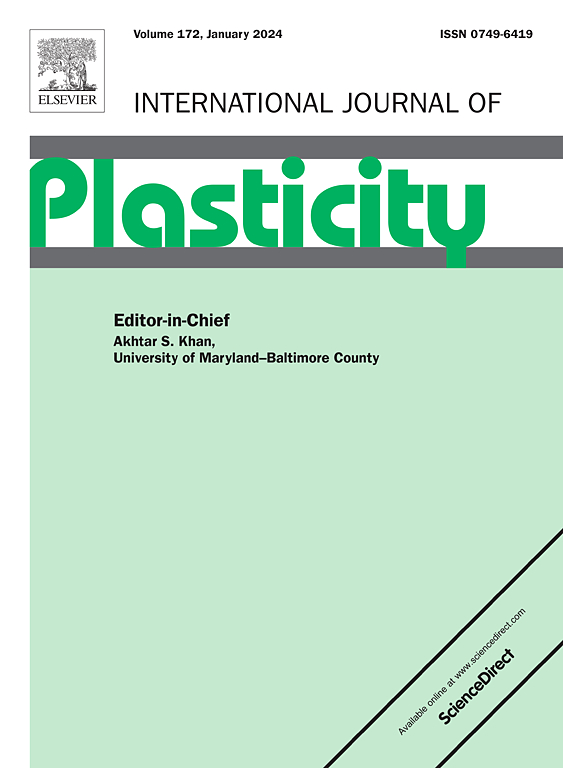Grain-scale micromechanical behaviors of hexagonal titanium utilizing in-situ high-energy diffraction microscopy and crystal plasticity finite element simulations
IF 9.4
1区 材料科学
Q1 ENGINEERING, MECHANICAL
引用次数: 0
Abstract
Coupling crystal plasticity finite element (CPFE) simulations with in-situ characterization techniques offers a robust framework for exploring the micromechanical behavior of polycrystalline metals. In this study, we tracked the evolution of the complete elastic strain tensor and orientation rotation of hundreds of grains in a hexagonal titanium (Ti) sample under uniaxial tension using in-situ high-energy diffraction microscopy (HEDM). These experimental observations were systematically compared to CPFE simulations instantiated with experimentally characterized results. It was found that CPFE simulations successfully replicate the macroscopic stress-strain response and texture evolution of polycrystalline Ti, however, only partially capture grain-scale micromechanical behaviors, particularly regarding grain-resolved elastic strains and orientation rotations. Detailed grain-to-grain comparison metrics reveal that incorporating residual stresses into CPFE models significantly improves the predictive accuracy of micromechanical behaviors. Moreover, simulations involving pyramidal <a> slip systems with high critical resolved shear stress, show slightly enhanced predictive performance. Further analyses of individual grains showcase how residual stresses and slip systems selections influence the micromechanical behaviors, highlighting the importance of the grain-scale stress state in determining deformation mechanisms. To understand the role of strain gradient effects in grain-scale stress heterogeneity, a non-local dislocation-based CPFE model was further compared to the phenomenological model discussed above. Although pronounced localized stresses and altered deformation mechanisms were observed near grain boundaries, the dislocation-based CPFE model still cannot significantly improve the predictions of grain-scale micromechanical behaviors. This work deepens the fundamental understanding of deformation mechanisms in hexagonal metals, and offers valuable insights into micromechanical modeling of polycrystalline materials.


利用原位高能衍射显微镜和晶体塑性有限元模拟六方钛的晶粒尺度微观力学行为
耦合晶体塑性有限元(CPFE)模拟与原位表征技术为探索多晶金属的微观力学行为提供了一个强大的框架。在这项研究中,我们使用原位高能衍射显微镜(HEDM)跟踪了六方钛(Ti)样品在单轴拉伸下的完整弹性应变张量的演变和数百个晶粒的取向旋转。这些实验观察结果与CPFE模拟实例化的实验表征结果进行了系统的比较。结果表明,CPFE模拟成功地复制了多晶Ti的宏观应力应变响应和织构演变,但仅部分捕获了晶粒尺度的微观力学行为,特别是在晶粒分解弹性应变和取向旋转方面。详细的晶粒间比较指标表明,将残余应力纳入CPFE模型可显著提高微观力学行为的预测精度。此外,涉及金字塔的模拟;具有高临界分解剪切应力的滑移系统的预测性能略有提高。对单个晶粒的进一步分析显示了残余应力和滑移系统选择如何影响微观力学行为,强调了晶粒尺度应力状态在确定变形机制中的重要性。为了了解应变梯度效应在晶粒尺度应力非均质性中的作用,我们进一步将基于非局部位错的CPFE模型与上述现象学模型进行了比较。尽管在晶界附近观察到明显的局部应力和改变的变形机制,但基于位错的CPFE模型仍然不能显著改善晶粒尺度微观力学行为的预测。这项工作加深了对六边形金属变形机制的基本理解,并为多晶材料的微观力学建模提供了有价值的见解。
本文章由计算机程序翻译,如有差异,请以英文原文为准。
求助全文
约1分钟内获得全文
求助全文
来源期刊

International Journal of Plasticity
工程技术-材料科学:综合
CiteScore
15.30
自引率
26.50%
发文量
256
审稿时长
46 days
期刊介绍:
International Journal of Plasticity aims to present original research encompassing all facets of plastic deformation, damage, and fracture behavior in both isotropic and anisotropic solids. This includes exploring the thermodynamics of plasticity and fracture, continuum theory, and macroscopic as well as microscopic phenomena.
Topics of interest span the plastic behavior of single crystals and polycrystalline metals, ceramics, rocks, soils, composites, nanocrystalline and microelectronics materials, shape memory alloys, ferroelectric ceramics, thin films, and polymers. Additionally, the journal covers plasticity aspects of failure and fracture mechanics. Contributions involving significant experimental, numerical, or theoretical advancements that enhance the understanding of the plastic behavior of solids are particularly valued. Papers addressing the modeling of finite nonlinear elastic deformation, bearing similarities to the modeling of plastic deformation, are also welcomed.
 求助内容:
求助内容: 应助结果提醒方式:
应助结果提醒方式:


